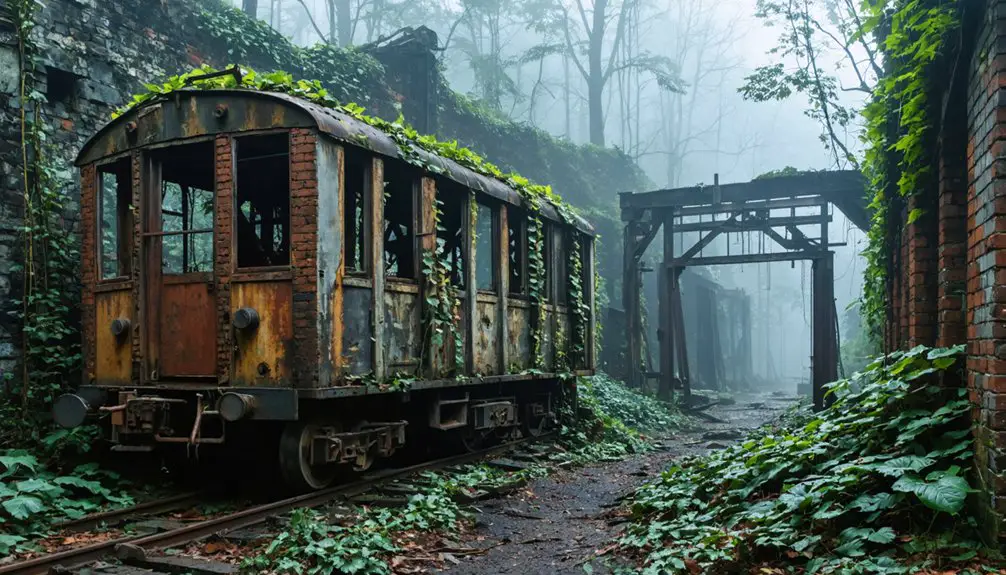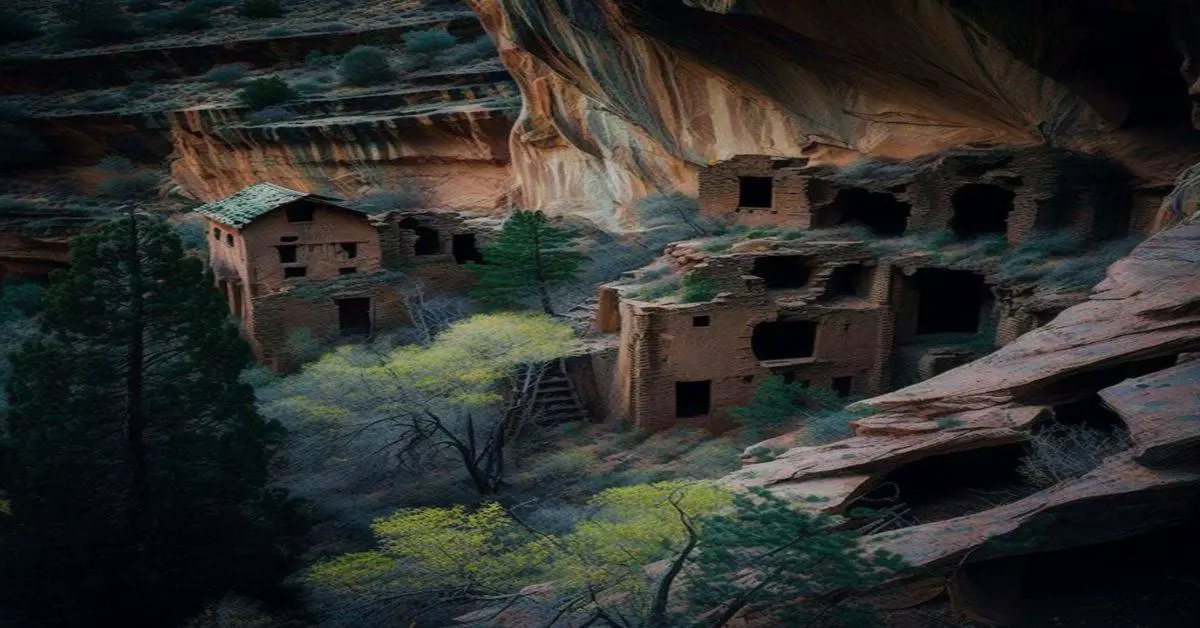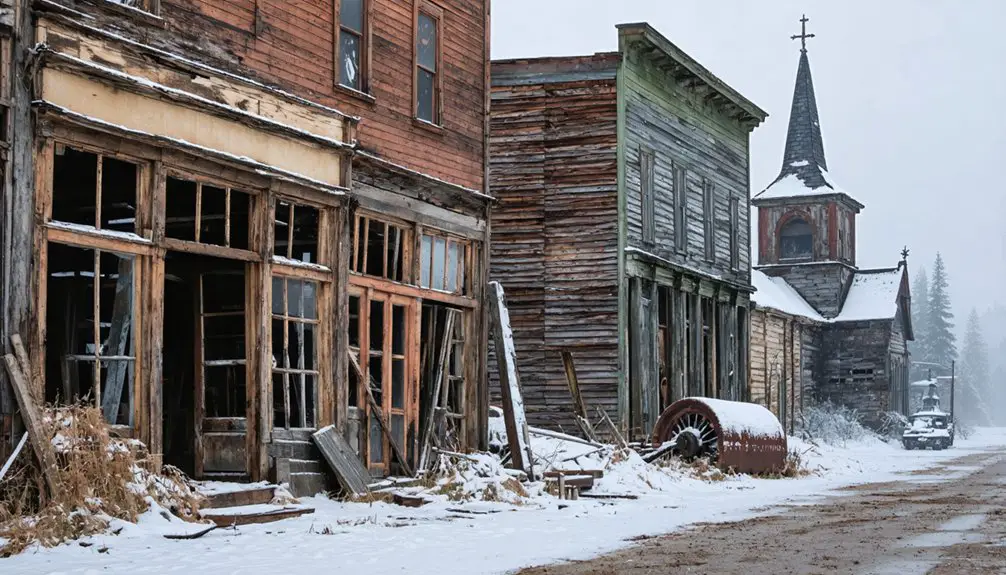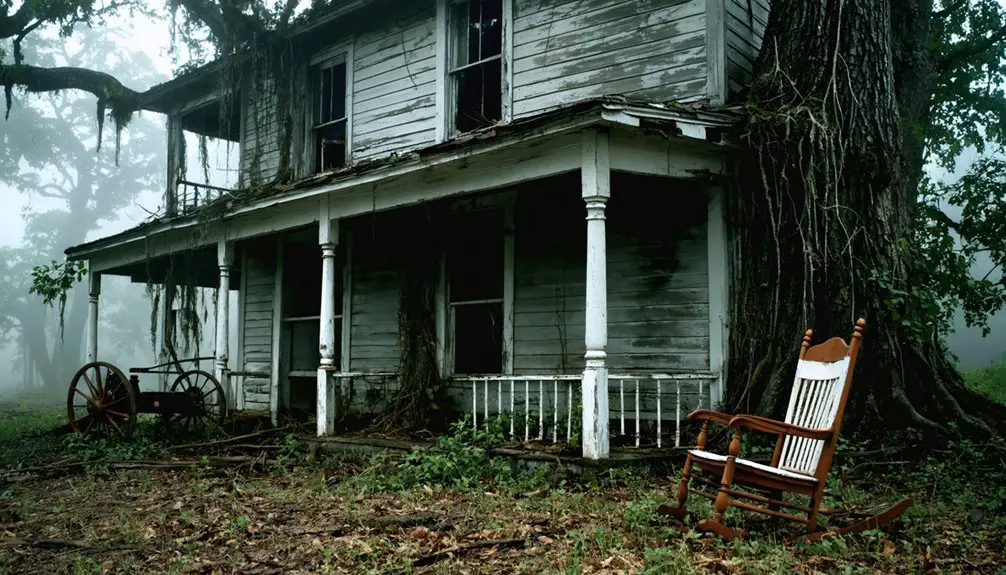You’ll discover Kaymoor’s haunting ruins in West Virginia’s New River Gorge, where coal mining operations thrived from 1900 to 1962. This two-tiered mining town, established by Low Moor Iron Company, featured innovative dual inclines spanning 1,000 feet of elevation. At its peak in 1923, 560 residents called Kaymoor home, with miners extracting 16.9 million tons of coal before economic shifts led to its abandonment. The preserved site’s mining artifacts and rail systems tell deeper stories of Appalachian industrial life.
Key Takeaways
- Kaymoor was a coal mining town established in 1900 that became abandoned by 1962 after producing 16.9 million tons of coal.
- The town featured a unique two-tiered design with Kaymoor Top and Bottom, connected by an innovative dual incline system.
- At its peak in 1923, Kaymoor’s population reached 560 residents who depended entirely on company-provided housing and amenities.
- The bottom camp was completely deserted by 1952, with the mine’s final closure in 1962 marking Kaymoor’s transition to ghost town status.
- Today, visitors can explore the preserved mining ruins and Kaymoor Miners Trail within the New River Gorge area.
The Rise of a Coal Mining Empire
In 1900, the Low Moor Iron Company established Kaymoor as a coal mining operation to fuel its iron furnaces in Virginia. Named after James Kay, who became the first mine superintendent, the town quickly took shape with two distinct centers: Kaymoor Top on the ridge and Kaymoor Bottom near the river and railroad.
By 1923, the thriving community had grown to include 560 residents, transforming from a simple mining camp into a vibrant town.
You’ll find that Kaymoor’s economic impact began immediately, with its first coal shipment on August 23, 1900, delivering 58,900 pounds via the Chesapeake & Ohio Railway.
The operation’s sophisticated infrastructure included dual inclines – one for workers and another for transporting coal to the processing facilities and coke ovens below. In its inaugural year, the mine produced 64,800 long tons of coal, setting the stage for what would become one of New River Gorge‘s most productive mining operations. The high-quality coal was processed into clean, lightweight coke, which proved highly profitable for the region’s iron industry.
Engineering Marvels of the Mountain
While many coal towns dotted the New River Gorge, Kaymoor’s engineering achievements set it apart through an intricate network of vertical transport systems.
Kaymoor’s innovative vertical transport networks distinguished it from other coal towns, showcasing the pinnacle of mining engineering along the New River Gorge.
The site’s dual incline technology mastered the challenging 1,000-foot elevation change, with a single track moving workers and equipment up to the mine portal, while a separate double track transported coal down to the processing facilities. The original operations relied on mule-drawn railcars for underground coal transport. The coal camp grew to include 130 company houses for the mining workforce.
You’ll find marvel in how the conveyor systems integrated seamlessly with the inclines, moving coal continuously from the Sewell Bench mine portal to Kaymoor Bottom.
This engineering ingenuity enabled the site to process over 16 million tons of coal during its 62-year run.
The complex included strategically positioned coke ovens near the river and a two-tier town layout that maximized efficiency while adapting to the gorge’s steep terrain.
Life in the Two-Tiered Mining Town
Located along the steep walls of New River Gorge, Kaymoor’s unique two-tiered design split the town between Kaymoor Top on the ridgeline and Kaymoor Bottom near the railroad tracks.
This physical division reflected the community dynamics of this company-controlled settlement, where 1,500 miners worked at its peak.
You’d find stark economic dependency throughout both tiers, with residents relying entirely on company-provided housing and amenities.
The town lacked independent institutions like churches or banks, offering only basic facilities such as company stores, segregated schools, and a pool hall.
Originally established to supply coal to Low Moor Iron Company furnaces in Virginia, the mine shaped the town’s industrial purpose.
As a worker, you’d earn either by the ton as a pick miner ($0.50) or daily wage as a machine miner ($2.25).
This controlled environment lasted until the 1950s, when declining operations led to the town’s gradual abandonment.
The site operated continuously until Barbara Gale Coal performed the last mining activities in 1964.
Working Deep in New River Gorge
Deep within New River Gorge‘s steep slopes, Kaymoor One mine operated through multiple working tiers, employing up to 1,500 miners who extracted 16.9 million tons of coal between 1900 and 1962.
You’d find a diverse workforce of African American migrants and European immigrants tackling the challenging terrain daily. The mine’s 821-step staircase connected workers between different operational levels.
Your mining techniques would’ve relied heavily on the steam-powered mountain haulage system, which transported workers, coal, and equipment between different levels.
Worker safety remained essential as you’d navigate the deep underground workings that required careful ventilation.
The 101 coke ovens processed coal until 1935, while the tipple near the river helped sort and load coal onto C&O Railway cars.
Despite harsh mountain conditions, you’d operate complex machinery and maintain the infrastructure needed to ship tens of thousands of pounds daily.
The Slow Fade Into History
As World War II drew to a close, Kaymoor’s once-bustling industrial landscape began its steady decline into abandonment. The depletion of coal seams and dropping demand triggered economic shifts that would seal the town’s fate.
By 1952, you’d find the bottom camp deserted as residents moved to higher ground, while improved roads and widespread car ownership let miners live wherever they chose.
The cultural erosion accelerated through the 1950s as community bonds weakened. The site’s Mountain Hol system transported workers and materials between levels using electric cables. Fires ravaged the remaining structures around 1960, and the mine’s closure in 1962 marked the end of Kaymoor’s industrial era.
Today, you’ll find only stone foundations, rusted equipment, and weathered coke ovens among the encroaching vegetation – evidence of a coal town that outlived most of its Appalachian counterparts by lasting 62 years.
Exploring Kaymoor’s Industrial Ruins Today
While descending the steep Kaymoor Miners Trail today, you’ll encounter one of West Virginia’s most complete preserved coal mining complexes. The strenuous 0.5-mile trek drops 900 feet through rocky stairs and switchbacks, leading you to remarkable industrial preservation from the early 1900s.
At the mine level, you’ll find weathered machinery, the historic No. 1 mine entrance, and remnants of the coal tipple. An impressive 17 million tons of coal were extracted from these mines during their operational years from 1900 to 1962.
For the adventurous, 821 wooden steps continue down to the processing plant and coke ovens. While exploring these fascinating ruins, you’ll need to respect visitor safety guidelines – avoid climbing on structures and stay clear of the active railroad tracks near river level.
The site’s dense foliage adds an eerie atmosphere while protecting these irreplaceable artifacts of America’s coal heritage.
Frequently Asked Questions
What Happened to the Residents of Kaymoor After the Mine Closed?
You’ll find the residents scattered, relocated to nearby towns like Fayetteville, faced economic hardship after the 1962 closure, and lost their tight-knit mining community as they sought new opportunities elsewhere.
Were There Any Major Mining Accidents or Disasters at Kaymoor?
You’ll find no major disasters in Kaymoor’s mining safety records. While accident reports show typical hazards like rock falls, fires, and electrocution incidents, the mine never experienced the devastating explosions common elsewhere.
How Much Did Kaymoor Miners Earn Compared to Other Mining Towns?
You’d find miners’ wages hard to compare directly, since company scrip and deductions greatly reduced take-home pay. The economic impact of earning $160,000 monthly payroll matched regional averages, but restricted spending freedom.
What Recreational Activities and Entertainment Were Available to Kaymoor Residents?
You’d find limited recreational facilities but could enjoy outdoor activities, community events, and informal gatherings. Baseball teams, card games, hiking, and fishing provided entertainment, while nearby towns offered additional diversions.
Did Any Original Buildings or Homes Survive and Remain Inhabited Today?
You won’t find any surviving structures still inhabited today – all original homes have crumbled into ruins. Only foundations and scattered remnants remain, overtaken by wilderness and preserved as historic artifacts.
References
- https://officialbridgeday.com/bridge-blog/history-of-kaymoor
- https://theclio.com/entry/22885
- https://www.coalcampusa.com/sowv/river/kaymoor/kaymoor.htm
- https://www.youtube.com/watch?v=Yyz6eJxCjbw
- https://www.atlasobscura.com/places/kaymoor-mines
- https://www.nps.gov/neri/learn/historyculture/kaymoor.htm
- https://www.youtube.com/watch?v=HmTqMVOkT3Q
- https://www.wvencyclopedia.org/entries/1107
- https://en.wikipedia.org/wiki/Kay_Moor
- https://www.onlyinyourstate.com/nature/west-virginia/creepiest-hike-wv



